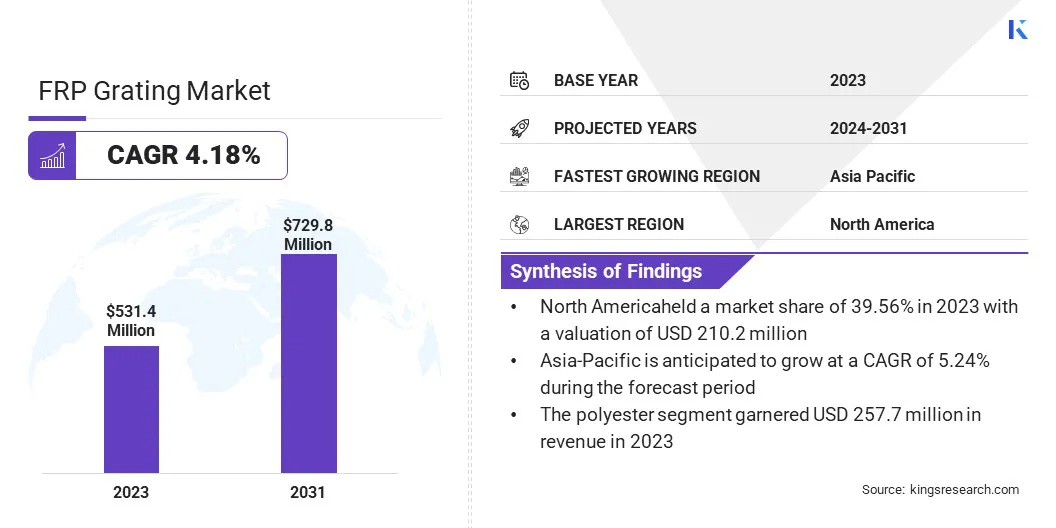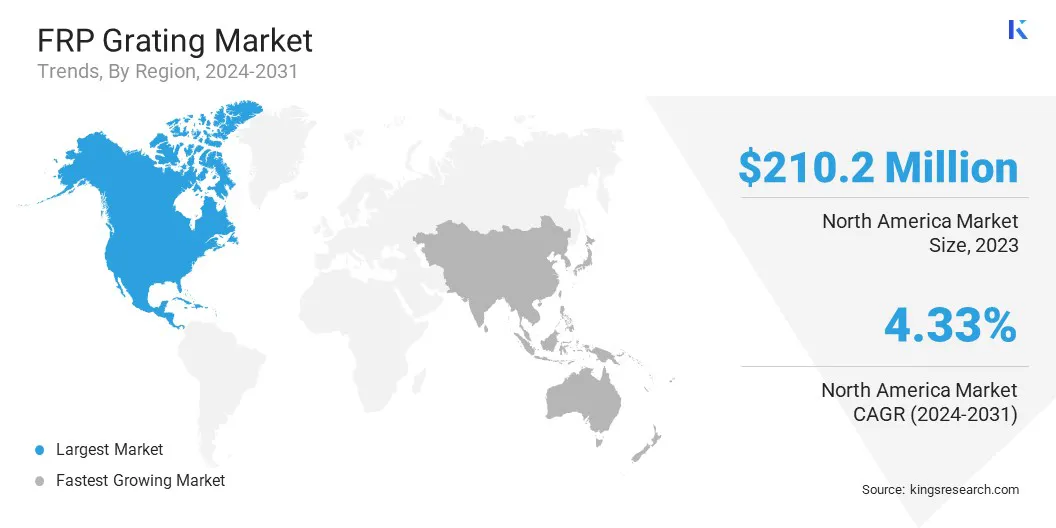FRP Grating Market Size
According to Kings Research, the global FRP Grating Market size was valued at USD 531.4 million in 2023 and is projected to grow from USD 547.8 million in 2024 to USD 729.8 million by 2031, exhibiting a CAGR of 4.18% during the forecast period. The growth of the market is driven by the increasing demand for durable, corrosion-resistant materials in industrial applications, advancements in manufacturing technologies, and a growing focus on safety and sustainability.
In the scope of work, the report includes solutions offered by companies such as Bedford Reinforced Plastics, Eurograte S.r.l., Exel Composites, Ferrotech International, Gebrüder MEISER GmbH, Indiana Gratings, Molymer Matex Co., Ltd., Techno-Composites Domine GmbH, McNICHOLS CO., STRONGWELL CORPORATION, and others.
The progress of the FRP (Fiber Reinforced Polymer) grating market is propelled by the increasing demand for corrosion-resistant and low-maintenance materials in industrial applications. The construction sector's expansion, particularly in emerging economies, amplifies this demand. Additionally, stringent regulations aimed at promoting worker safety in hazardous environments bolster the adoption of FRP grating, which is known for its slip resistance and durability.
- For instance, in August 2023, Bedford Reinforced Plastics developed the ReadyStair pre-engineered FRP stair towers and stairs in response to OSHA’s stringent safety standards for workplace stairs. These fiberglass-reinforced plastic solutions met OSHA requirements by offering corrosion resistance, durability, and safety features such as fire-retardant materials and anti-slip surfaces, addressing the limitations associated with traditional materials, including metal and wood.
Innovations in manufacturing processes and the rising trend of replacing traditional materials with FRP due to their lightweight and high-strength properties further boost market expansion. The growing focus on sustainable and eco-friendly materials further augments the growth of the market.
The global FRP grating market is experiencing robust growth due to its extensive use across various industries, including construction, marine, and oil and gas. With the continuous advancements in FRP grating technology, the market is witnessing increased adoption across diverse sectors.
The Asia-Pacific region leads the market, mainly due to rapid industrialization and infrastructure development in countries such as China and India. Key market players are focusing on strategic collaborations and product innovations to strengthen their market position and expand their customer base.
Fiber Reinforced Polymer grating, (FRP grating) is a composite material made from a polymer resin matrix reinforced with fibers, typically glass or carbon. This material is designed to provide a high-strength, lightweight, and corrosion-resistant alternative to traditional materials such as steel and aluminum.
FRP grating is widely used in environments where durability, safety, and maintenance are critical, such as in chemical plants, wastewater treatment facilities, and offshore platforms. Its inherent properties, such as high tensile strength, resistance to chemical and environmental damage, and ease of installation, make it a preferred choice for applications that demand robust and reliable performance.

Analyst’s Review
Manufacturers in the FRP grating market are continuously innovating to meet growing industry demands. These efforts include the development of eco-friendly materials and the integration of advanced manufacturing technologies such as pultrusion and vacuum infusion. These innovations are enhancing product quality and reducing costs.
New product launches, that emphasize high strength and corrosion resistance are increasingly gaining traction in industrial applications. To sustain competitiveness, companies are advised to invest in R&D and form strategic partnerships to expand their market reach.
Additionally, educating potential customers about the long-term benefits and cost savings associated with FRP grating is crucial for promoting its adoption and ensure sustained market growth.
- For instance, in October 2023, Eurograte Group expanded its manufacturing site in Loreo (RO) by introducing new machinery and facilities to enhance its production capabilities for composite gratings. This expansion aligned with OSHA regulations by improving safety standards and increasing efficiency in FRP grating production. The investment in over 20,000 m² and advanced technology strengthened Eurograte’s position as a leader in the European market.
FRP Grating Market Growth Factors
The increasing need for durable and corrosion-resistant materials in industrial applications is propelling the expansion of the FRP grating market. Industries such as chemical processing, oil and gas, and wastewater treatment are continuously seeking materials capable of withstanding harsh environment conditions.
FRP grating is becoming a preferred choice due to its superior resistance to chemicals and environmental factors, which results in lower maintenance costs and reduced downtime.
Additionally, the material's lightweight nature facilitates easy handling and installation, thereby enhancing its appeal. This growing demand for efficient, long-lasting materials is propelling the adoption of FRP grating across various industrial sectors, thereby contributing significantly to market growth.
The high initial cost compared to traditional materials present a significant challenge to the development of the market. This cost factor may deter small and medium-sized enterprises from adopting FRP grating. However, this challenge is being addressed through increased awareness associated with the long-term benefits of FRP grating.
Companies are highlighting that the reduced maintenance costs, longer lifespan, and improved safety features effectively justify the initial investment. Additionally, advancements in manufacturing technologies are gradually lowering production costs, making FRP grating more affordable. By emphasizing the total cost of ownership and ongoing innovations, market participants are addressing the barrier of high initial costs.
FRP Grating Market Trends
The market is experiencing a significant trend toward the development and adoption of eco-friendly materials. Manufacturers are increasingly focusing on producing FRP grating using sustainable raw materials and energy-efficient processes. This trend is further bolstered by rising environmental awareness and stringent regulations aimed at reducing carbon footprints.
Companies are investing heavily in research and development to create recyclable and biodegradable FRP grating products. This shift aligns with global sustainability goals and appeals to environmentally conscious consumers and industries, thereby expanding the market reach and enhancing the competitive advantage of eco-friendly FRP grating products.
Another notable trend in the FRP grating market is the growing integration of advanced manufacturing technologies. Techniques such as pultrusion and vacuum infusion are becoming increasingly prevalent, allowing for higher precision and consistency in FRP grating production. These advanced methods improve the structural integrity and performance of the grating, making it more suitable for high-stress applications.
Additionally, the widespread adoption of automation and digitalization in manufacturing processes is enhancing production efficiency and reducing costs. This shift toward technological advancements is enabling manufacturers to meet the increasing demand for high-quality FRP grating while maintaining competitive pricing and delivery timelines.
Segmentation Analysis
The global market is segmented based on resin type, end use, application, and geography.
By Resin Type
Based on resin type, the market is categorized into polyester, vinyl ester, phenolic, and others. The polyester segment led the FRP grating market in 2023, reaching a valuation of USD 257.7 million. This notable expansion is facilitated by its cost-effectiveness and versatile properties, which render it the preferred choice for various applications.
Polyester resin is known for its excellent mechanical strength and chemical resistance, making it suitable for use in challenging environments. Its ease of processing and molding capabilities further increase its popularity. Additionally, polyester resin offers a favorable balance between performance and affordability, which particularly appeals to budget-conscious industries.
The growing demand from sectors such as construction, marine, and industrial applications, coupled with the increasing emphasis on durability and low maintenance, is boosting the expansion of the polyester segment.
By End Use
Based on end use, the market is classified into industrial, water management, cooling towers, marine, and others. The industrial segment is set to witness significant growth at a CAGR of 4.87% through the forecast period (2024-2031), largely due to the rising demand for durable and high-performance materials in various industrial applications.
Industries such as chemical processing, oil and gas, and manufacturing require materials that are capable of withstanding extreme conditions while ensuring safety and reliability. FRP grating, known for its superior strength, corrosion resistance, and non-conductive properties, is increasingly being adopted in these settings. The rising focus on workplace safety, regulatory compliance, and the pressing need for cost-effective, low-maintenance solutions are further propelling the growth of the industrial segment.
By Application
Based on application, the market is segmented into stair treads, walkaways, platforms, and others. The stair treads segment secured the largest FRP grating market share of 34.99% in 2023. The segment is leading the market as a result of its critical role in ensuring safety and durability in various environments.
FRP grating stair treads are widely used in industrial, commercial, and public infrastructure projects where slip resistance, strength, and low maintenance are essential requirements.
The inherent properties of FRP grating, such as corrosion resistance and lightweight, make it an ideal material for stair treads in harsh and demanding conditions. The increasing focus on safety regulations and the rising need for long-lasting, reliable materials in high-traffic areas are leading to the widespread adoption of FRP grating stair treads.
FRP Grating Market Regional Analysis
Based on region, the global market is classified into North America, Europe, Asia-Pacific, MEA, and Latin America.

North America FRP grating market captured a substantial share of around 39.56% in 2023, with a valuation of USD 210.2 million. This dominance is reinforced by the region's well-established industrial base and stringent safety regulations. The region's extensive oil and gas, chemical processing, and wastewater treatment industries demand high-performance materials such as FRP grating, which is known for its durability and corrosion resistance.
Additionally, strong infrastructure development and maintenance projects fuel the need for reliable and long-lasting materials. The presence of key market players and ongoing technological advancements further aid regional market growth. Government regulations aimed at promoting workplace safety and environmental sustainability further contribute to the domestic market development.
Asia-Pacific is poised to experience robust growth at a CAGR of 5.24% through the projection period, largely attributed to rapid industrialization and infrastructure development. Countries such as China and India are investing heavily in construction, water management, and industrial projects, leading to increased demand for durable and low-maintenance materials.
The growing population and rapid urbanization in the region are highlighting the pressing need for advanced infrastructure and public safety solutions, where FRP grating plays a crucial role. Additionally, the growing shift toward eco-friendly and sustainable materials is boosting adoption, thereby supporting regional market expansion.
Competitive Landscape
The global FRP grating market report will provide valuable insight with an emphasis on the fragmented nature of the industry. Prominent players are focusing on several key business strategies such as partnerships, mergers and acquisitions, product innovations, and joint ventures to expand their product portfolio and increase their market shares across different regions.
Manufacturers are adopting a range of strategic initiatives, including investments in R&D activities, the establishment of new manufacturing facilities, and supply chain optimization, to strengthen their market standing.
Key Companies in FRP Grating Market
- Bedford Reinforced Plastics
- Eurograte S.r.l.
- Exel Composites
- Ferrotech International
- Gebrüder MEISER GmbH
- Indiana Gratings
- Molymer Matex Co., Ltd.
- Techno-Composites Domine GmbH
- McNICHOLS CO.
- STRONGWELL CORPORATION
Key Industry Developments
- July 2024 (Expansion): National Grating announced the opening of its new facility in Woodstock, Ontario, Canada. This expansion was in response to the rising demand for FRP products and highlights the company's commitment to customer service. The new facility features a large inventory of custom fabrication services, FRP materials, and enhanced logistics to better serve contractors, metal fabricators, and construction companies in Ontario and North America.
- February 2024 (Partnership): Exel Composites secured a project with Foton Bus and Coach Company, a Chinese automotive manufacturer, to supply locally manufactured pultruded glass fiber composite profiles. These profiles were designed to reduce vehicle weight and maintenance due to their light weight and corrosion resistance properties, providing superior design flexibility compared to traditional metals such as aluminum and steel. Exel Composites produced various structural composite profiles tailored for different bus models, thereby enhancing durability and reducing density.


